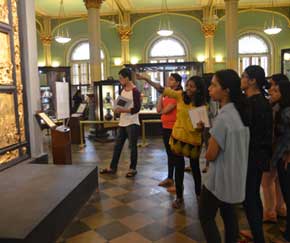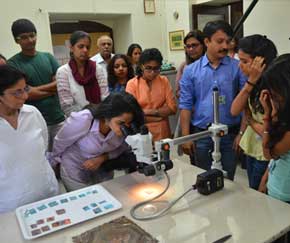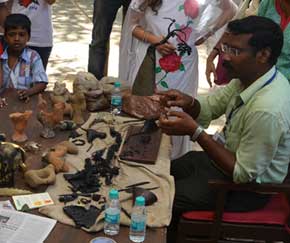
![]() Industrial Arts Gallery | Kamalnayan Bajaj Special Exhibitions Gallery | Special Project Space
Industrial Arts Gallery | Kamalnayan Bajaj Special Exhibitions Gallery | Special Project Space
The Museum hosted an acclaimed masterpiece of the Florentine Renaissance, Lorenzo Ghiberti’s (Italian, 1378-1455) The Gates of Paradise (1425-52). On display in India for the first time, the full-scale lost-wax bronze replica of the Gates, cast from the original mould, allowed visitors to discover Ghiberti’s masterpiece and to contextualise the civic values promoted by the great art of the period. The Gates of Paradise reflect the artistic, political, religious, and social contexts of Ghiberti and his patrons in fifteenth-century Florence. At the Museum, The Gates of Paradise evoked a fascinating thematic parallel between the artistic climate and civic values that shaped the Florentine Renaissance and the extraordinary Indian patronage and entrepreneurship that created Mumbai. The exhibition offered visitors a rare experience of the civic values that gave birth to the Florentine Renaissance – values that carry significant implications for the development of urban culture in a rapidly-urbanizing India.
Organized by the Dr. Bhau Daji Lad Mumbai City Museum in collaboration with the Guild of the Dome Association, the Kunsthistorisches Institut in Florenz, Max-Planck-Institute, and the Museum of the Opera del Duomo. Supported by the Jamnalal Bajaj Foundation.
Florentine Renaissance - Sharing Universal Values Through Art
The proposed exhibition to be held in India is based on the presentation of one of the World most acclaimed masterpieces: The “Gates of Paradise” made by Lorenzo Ghiberti in Florence from 1425 to 1452. The full size,
museum quality, bronze replica of this masterpiece is the center of the exhibition. These doors depict stories of the Bible, in particular the Old Testament, and by means of these narrative scenes the artist and his
patrons explore artistic, social, political and religious dynamics of their own time. The doors thus offer the unique opportunity to describe the extraordinary creative climate and civic values of the Florentine
Renaissance, and share it with the Indian public.
Many different elements contribute to the best achievements of mankind in all great world cultures, such as the Italian and the Indian. The Renaissance was the result of humanism, art, technical mastery, organizational
skills, and wealth, all contributing together to the artistic and economic development of the city and its territory, and thus setting new standards. For these reasons “Florentine Renaissance - Sharing Civic Values Through
Art” is the proposed theme of this exhibition. It will be the first one ever in India presenting Renaissance Florence, and through an articulated, and also visually, well documented story, show its relevance for an Indian
audience, primarily in cities like Mumbai and Delhi.
The doors of Ghiberti, named “Gates by Paradise” by Michelangelo, were placed in one of the crucial points of Florence, the Baptistry which is the oldest civic temple of the city, and the centre of the most important
urban rituals and performances. With the erection of the cathedral and the famous cupola of Brunelleschi a world unique ensemble has been created during the 14thand early 15th century. The doors of Paradise completed this
ensemble by defining the urban space as an unique combination of artistic, religious and political aspects which were fundamental to the Florentine society, its guilds and its elites, mostly merchants, textile entrepreneurs
and bankers, working all over Europe, the Mediterranean and Asia (also in India).
Taking these aspects into account, the exhibition will show the high quality replica of the Gates of Paradise not as an isolated token of artistic and technical excellence, but within the urban and historical context
which allowed its creation. By doing so, the exhibition will present the bronze gates as an “ambassador” of Renaissance Florence, surrounding them with an exhibition of historical and contemporary photographs of highest
quality. These will be possible due to a loan from the rich collections of the Kunsthistorisches Institut. The photographic exhibition and other visual material will allow the Indian public to experience the urban
environment and the public spaces of Florence which were the stage and the expression of a dynamic nd world-open society.
This ambitious project will be made possible thanks to the exceptional collaboration of Mrs. Tasneem Mehta – Honorary Director, Dr. Bhau Daji Lad Museum, Prof. Dr.Timothy Verdon - Director of the Museum of the Opera
del Duomo in Florence, and Prof.Dr. Gerhard Wolf - Director of the Kunsthistorisches Institute in Florence (Max-Planck-Institute). With their respective exceptional knowledge and experience, they will join forces to
achieve an extraordinary synthesis of art, social and religious history. The result will be certainly profoundly appreciated and admired by the Indian audience.
This exhibition is made possible by the commitment and the support of the Opera del Duomo Foundation and the Guild of the Dome Association. The Opera del Duomo foundation was established in 1296 by the Florentine Guilds
to finance, organise, and manage the construction of what is today the largest monumental complex in private hands in the Western World. The Opera is still a private, non-political and non-religious foundation,
responsible for the maintenance of the complex, and of the collections of masterpieces it contains.
The Guild of the Dome Association, in a way similar to the Guilds that started the Opera of the 13th century, is founded by global entrepreneurs from all over the World, from different cultures, faiths, and economic
environments. Our mission is “Sharing Universal Values Through Art”. In the globalized world of today the members of the Guild believe that it is the duty of successful individuals to help emphasize the common values,
across people of all continents, to offset the stress too often placed on the divisive factors.
The museum quality replica is available for this exhibition from early 2014, and it is identical to the replica now placed outdoor on the Baptistery in Florence herself. The original masterpiece, after over twenty
years of restoration, is now permanently located inside the Museum of the Opera itself. The replica allows to demonstrate the combination of technical invention in the bronze casting and the artistic creativity to the
Indian public and invites the visitors to a comparison to artistic traditions and technologies of their own culture.
This exhibition is important and significant because it helps building the first bridge between the Florentine social and economic environment and Indian cities, world famous for their entrepreneurship, craftsmanship,
artistic vocation, similar, yet different to the Florentine ones.
With its wealth of artistic treasures and its Medieval and Renaissance buildings, Florence in the 19th century was not only a tourist attraction and market for art and antiques,
but it had also become a place where the young discipline of art history flourished, and this led to a great interest in photographic documentation.
Photography played an essential role in creating the "myth of Florence" in the 19th century. Shifting between a medium of experimentation, art and souvenir, photography met various requirements and performed several functions. Photographic reproductions of famous buildings and works of art were, however, not limited to acting solely as souvenirs for travellers or research tools of art aficionados, who bought photographs as the raw material upon which to base their studies. Florence's flourishing antique business also benefited from the photographic representations of artistic subjects. Precisely for this reason, photography played an important role in the dissemination of Florentine works of art. Enlarged reproductions often adorned the homes of bourgeois scholars and amateurs.
The urban transformations that occurred after Florence became the capital of the newly formed Italian nation were accompanied by photographic campaigns.
This photographic exhibition is based on the collection of the Kunsthistorisches Institut in Florence and combines two intertwined aspects: the pictorial evocation of the Florentine city space, and
the history of its representation through the medium of photography between 1860 and 1960 in a variety of techniques, reproduced here in digital prints, and a number of originals from 1900 to 1950.
Co-curated by Gerhard Wolf and Prof. Timothy Verdon
In collaboration with The Guild of the Dome, The Kunsthistorisches Institut, Florence and The Museum of the Opera del Duomo.

Free and open to all tours of the exhibition in English, Hindi and Marathi were conducted by the Museum’s curatorial team every Saturday and Sunday through April and May 2014.

In this workshop, participants explored renowned sculptor Lorenzo Ghiberti's Gates of Paradise (1425-52), an acclaimed masterpiece of the Florentine Renaissance. With the help of the education team,
they deciphered biblical panels that tell stories from the Old Testament, discovering the science behind the art, and Ghiberti's means of narrative building and creating the illusion of space and
distance in a two-dimensional field. Participants then used these tools to mould their own stories in clay.
This workshop was offered to schools, for students aged 6 and above, on request throughout the duration of the exhibition.
Five sessions of this workshop were also conducted during the Summer Workshops programme, Story time at the Museum, in May 2014.

Participants had the unique opportunity to go behind the scenes at the INTACH Mumbai Conservation Lab at the Museum and learn about the transformation of the Museum building and collection from
2003 - 2008. An interactive demonstration on metal conservation processes by the conservators allowed participants to engage more closely with the restoration of renowned sculptor Lorenzo Ghiberti's Gates
of Paradise (1425-52).
Dates: April 26 & May 24, 2014

Audiences of all ages had the opportunity to explore the different stages in the lost wax technique, interact with practising artisans, try their hand at moulding a wax object and watch a video documenting the entire
process. Practiced in India for centuries, the lost wax technique was used Lorenzo Ghiberti in creating the Gates of Paradise in the 15th century.
Dates: 24 & 25 May, 2014
The Dr. Bhau Daji Lad Museum, Mumbai City Museum seeks to serve the community as an Institution dedicated to excellence in cultural education through exhibitions and unique visual and intellectual media



An Institution of the Municipal Corporation of Greater Mumbai. Supported by the Jamnalal Bajaj Foundation. Restored by INTACH, Indian National Trust for Art and Cultural Heritage
Dr. Bhau Daji Lad Museum
Veermata Jijabai Bhosale Botanical Udyan and Zoo (Rani Baug),
91/A, Dr Babasaheb Ambedkar Road,
Byculla East Mumbai 400027 India
Museum Plaza is located right behind the Museum building
T: +91 22 23741234
10 am - 5:30 pm